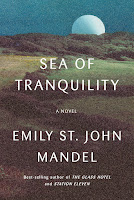Book Review: Sea of Tranquility by Emily St. John Mandel
 |
In 1912, eighteen-year-old Edwin St. Andrew finds himself crossing the Atlantic after being exiled by his aristocratic family in England on account of his disparaging remarks on colonialism at his family’s dinner table. His travels take him to Canada and eventually he lands in the settlement in Caitte. Here, one day while walking in the woods, he experiences “a flash of darkness, like sudden blindness or an eclipse. He has an impression of being in some vast interior, something like a train station or a cathedral, and there are notes of violin music, there are other people around him, and then an incomprehensible sound” - an unnatural experience he shares in a letter to his family. In the summer of 1994, thirteen-year-old Vincent Smith is walking through the same woods recording her surroundings on video – a recording that her composer brother shares accompanied with his background score during a 2020 performance in New York City – a video that has a glitch- sudden darkness accompanied by violin music, a "whoosh” sound, a “dim cacophony”- that lasts a few moments. In the year 2203, an author by the name of Olive Llewellyn, a resident of the second moon colony, travels to Earth on a book tour to promote her post-apocalyptic novel, "Marienbad" which revolves around a pandemic. A passage in her novel describes one of her characters who, while traveling through Oklahoma City Airship Terminal stops to listen to a violinist and experiences “a fleeting hallucination of forest, fresh air, trees rising around him, a summer’s day”.
An anomaly? A glitch in a simulated reality? A file corruption? A break in reality? Are discrete realities bleeding into each other?
In the year 2401, Gaspery-Jacques Roberts, a security professional employed with the Grand Luna Hotel in the first moon colony - is hired by the Time Institute and is assigned to investigate these unnatural occurrences . Gaspery travels back and forth through time and space , visiting and revisiting the people and the places, witnessing the mysterious events. He meets the son of the aristocrat, the brother and a close friend of the young girl who recorded the video and the author who admits her passage was based on an experience she had traveling through the same terminal. He also finds a fourth individual – the violinist Alan Sami whose music features in those visions. In the course of his travels, he comprehends the fragility of time travel and the ripples that any anomaly can create and finds it increasingly difficult to exercise the “almost inhuman level of detachment” that is required of him on his mission knowing that any manipulation of the timeline will bring with it dire consequences for himself.
A lot is going on in this relatively short novel (my ebook was 252 pages long) but the author’s narrative is structured such that it never feels rushed or too heavy. The author combines themes of time travel, life-threatening pandemics, space travel and other futuristic elements in a tightly woven narrative. The speculative /sci-fi elements are presented in a light and uncomplicated manner and strike a fine balance with the human element of the novel and the themes of family, survival, hope and humanity. Initially, the multiple threads of this novel may seem a tad disjointed, but the author does a marvelous job building up the suspense and brings everything together with a surprising revelation at the end. I also found the discussion (from the perspective of Olive Llewellyn) on the factors that influence the popularity of post-apocalyptic fiction quite interesting.
“I think, as a species, we have a desire to believe that we’re living at the climax of the story. It’s a kind of narcissism. We want to believe that we’re uniquely important, that we’re living at the end of history, that now, after all these millennia of false alarms, now is finally the worst that it’s ever been, that finally we have reached the end of the world.”
I fell in love with Emily St. John Mandel’s writing after reading Station Eleven– a feeling that was reinforced after reading The Glass Hotel. Naturally, my expectations were high for Sea of Tranquility. With masterful storytelling , themes that resonate and concise and straightforward prose in a well-paced narrative that keeps you turning pages till the very end, Sea of Tranquility does not disappoint! There are references to events and characters from The Glass Hotel and Olive Llewellyn’s novel "Marienbad" appears to be similar to the author’s Station Eleven .Though I feel reading The Glass Hotel prior to this novel would enrich the reading experience, Sea of Tranquility can be enjoyed as a standalone novel for those who have not read The Glass Hotel . I was thrilled to receive a "skip-the-line loan" from my local library! I promptly set aside my other 'current' reads and finished this book in a day. I know it is only April but I am confident that this novel will feature among my top 10 reads of 2022!
Comments
Post a Comment